

5 Classroom Management Tips For Every Teacher. This week we’re going to visit five classroom management tips all teachers can benefit from, new and veteran alike.
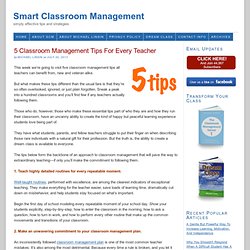
But what makes these tips different than the usual fare is that they’re so often overlooked, ignored, or just plain forgotten. Sneak a peak into a hundred classrooms and you’ll find few if any teachers actually following them. Those who do, however, those who make these essential tips part of who they are and how they run their classroom, have an uncanny ability to create the kind of happy but peaceful learning experience students love being part of. They have what students, parents, and fellow teachers struggle to put their finger on when describing those rare individuals with a natural gift for their profession. But the truth is, the ability to create a dream class is available to everyone. The tips below form the backbone of an approach to classroom management that will pave the way to extraordinary teaching—if only you’ll make the commitment to following them. 1. The Key To Classroom Organization.
A sharp, well-maintained classroom sends so many wonderful and powerful messages to students—from an expectation of excellence to personal pride in their work habits.
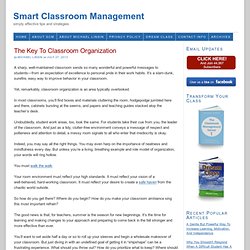
It’s a slam-dunk, surefire, easy way to improve behavior in your classroom. Yet, remarkably, classroom organization is an area typically overlooked. A Simple Way To Curb Side-Talking. Side-talking can be especially frustrating because, although it’s done out of earshot, it’s remarkably disruptive.
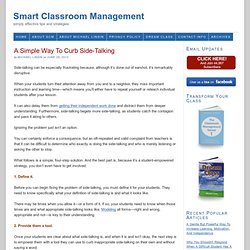
When your students turn their attention away from you and to a neighbor, they miss important instruction and learning time—which means you’ll either have to repeat yourself or reteach individual students after your lesson. It can also delay them from getting their independent work done and distract them from deeper understanding. Furthermore, side-talking begets more side-talking, as students catch the contagion and pass it along to others. Ignoring the problem just isn’t an option. You can certainly enforce a consequence, but an oft-repeated and valid complaint from teachers is that it can be difficult to determine who exactly is doing the side-talking and who is merely listening or asking the other to stop.
What follows is a simple, four-step solution. 1. How To Build Effortless Rapport. Because it’s one of the most effective and most powerful ways to influence behavior, having a natural, trusting rapport with your students is crucial.
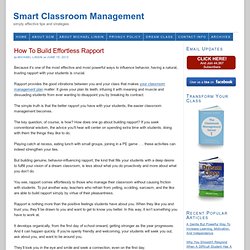
Rapport provides the good vibrations between you and your class that makes your classroom management plan matter. It gives your plan its teeth, infusing it with meaning and muscle and dissuading students from ever wanting to disappoint you by breaking its contract. The simple truth is that the better rapport you have with your students, the easier classroom management becomes. The key question, of course, is how? How does one go about building rapport? Classroom Management: It’s More Than a Bag of Tricks by Tracey Garrett.
Smart Classroom Management. How To Handle Sleepy, Unprepared, And Unmotivated Students. They enter your classroom bleary eyed.
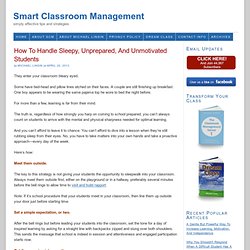
Some have bed-head and pillow lines etched on their faces. A couple are still finishing up breakfast. One boy appears to be wearing the same pajama top he wore to bed the night before. For more than a few, learning is far from their mind. The truth is, regardless of how strongly you harp on coming to school prepared, you can’t always count on students to arrive with the mental and physical sharpness needed for optimal learning. Positive, Not Punitive, Classroom Management Tips. This article is adapted from Larry's new book, Self-Driven Learning: Teaching Strategies for Student Motivation.

Let's start with a question I've been asked on more than one occasion. "I know my content and like my students, but sometimes it's hard to get them under control so I can teach my lesson. The Most Common Speaking Mistakes Teachers Make: Part 1. How you speak to your class matters—a lot.
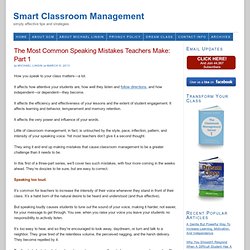
It affects how attentive your students are, how well they listen and follow directions, and how independent—or dependent—they become. It affects the efficiency and effectiveness of your lessons and the extent of student engagement. How To Manage Voice Levels In Your Classroom. Like so much of classroom management, the key to managing voice levels is to define for your students what you expect of them—and then hold them to it.
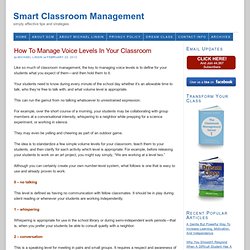
Your students need to know during every minute of the school day whether it’s an allowable time to talk, who they’re free to talk with, and what volume level is appropriate. This can run the gamut from no talking whatsoever to unrestrained expression. For example, over the short course of a morning, your students may be collaborating with group members at a conversational intensity, whispering to a neighbor while prepping for a science experiment, or working in silence. They may even be yelling and cheering as part of an outdoor game. Top 12 Classroom Management Dos and Don’ts. Does this sound familiar?

You labored all night creating a thoughtful, engaging lesson. You were confident that your students would enjoy it, only to have your excitement—and theirs—dashed by the antics of a handful of students. You spent all your time writing names on the board, calling out troublemakers’ names, and “ssshh-ing” them. Why Rules And Consequences Aren’t Enough. Lately, I’ve been receiving emails from teachers wondering why they have so many students in time-out every day, so I think it’s a good time to revisit a few core principles of Smart Classroom Management.
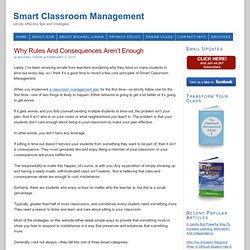
When you implement a classroom management plan for the first time—or strictly follow one for the first time—one of two things is likely to happen: Either behavior is going to get a lot better or it’s going to get worse. Smart Classroom Management. How To Manage Whole-Class Behavior While Working With A Small Group. It’s frustrating. You start your class working on an independent project, a writing assignment, or a rotation of centers, then begin quietly calling selected students for small-group instruction.
And for the first few minutes it goes well. 12 Classroom Rules We Could All Learn From. How Students Benefit From Using Social Media 12.73K Views 0 Likes A lot of criticism has been leveled at social media and the effect it has on the way students process and retain information, as well as how distracting it can be.
Calm, Focused & Happy. Rapport & Influence. Classroom Management Strategies. Handling Parents. Classroom Management Tips. What Effective Teachers Do. Teacher Modeling. Rules & Consequences. Why Reminders Make Classroom Management More Difficult. If there is one classroom management mistake made more often than others, it is the practice of giving reminders after misbehavior has already occurred. It’s so common, in fact, that it passes the lips of many scores of teachers daily—even hourly—in schools from Fresno to Timbuktu. “Excuse me . . . excuse me . . . boys and girls? There is no talking when I’m talking.” “Leila, go sit down right now. You know you may not leave your seat whenever you feel like it.” “Anthony and Eric, we don’t push in line. Anytime you spell out for your students what they should or shouldn’t be doing—based on behavior standards previously taught—you’re giving a reminder.
And teachers in the habit of reminding often struggle with classroom management. Here’s why:
Classroom Management Plan. Attentiveness. First Days of School. Difficult Students.